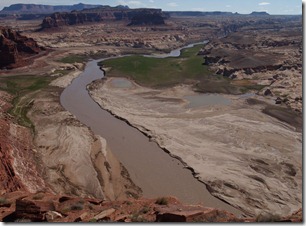Utah taps about 1 million acre-feet of Colorado River watershed water a year, with some of that piped to the urban Wasatch Front where nearly everyone in the state lives. Under an interstate compact, Utah has rights to another 400,000 acre-feet, though about half of that is reserved for the Ute and Navajo tribes. A planned pipeline from Lake Powell to St. George would bite into the remainder, as would population growth that’s expected to need another 40,000 acre-feet — each acre-foot being about what it takes to supply a family for a year. According to a U.S. Interior Department report, the Colorado River Basin likely will lose about 9 percent of its annual runoff by mid-century because of a warming climate, further squeezing Utah and its neighbors in a region that already expects to struggle getting water to its growing population. Bureau  of Reclamation scientists calculated likely regional temperature and precipitation models based on a range of possible carbon dioxide emissions, then used the mean of the results to predict an 8.5 percent reduction in water supply. The report actually predicts a 2.1 percent increase in precipitation for the Upper Colorado Basin — of which Utah is a part — but temperatures 5 to 7 degrees warmer than today’s are expected bring more rain than snow, and enough more evaporation to sap the supply. In the Lower Colorado Basin, precipitation is expected to decline 1.6 percent. "Water is the lifeblood of our communities, rural and urban economies and our environment," Interior Secretary Ken Salazar said in a statement, "and small changes in water supplies or the timing of precipitation can have a big impact on all of us." The report, a requirement of the Secure Water Act of 2009, projects wetter conditions in the Northwest and north-central United States, and further drying out in the Southwest. Even where moisture increases, winter rains — in place of snows — may decrease springtime and summer runoff for irrigation. The region’s smaller reservoirs may have to alter operations to keep water available late in the summer. But even in parts of the Interior West, where more rain falls in the future, the increased evaporation is likely to reduce river flows. Drink up.
of Reclamation scientists calculated likely regional temperature and precipitation models based on a range of possible carbon dioxide emissions, then used the mean of the results to predict an 8.5 percent reduction in water supply. The report actually predicts a 2.1 percent increase in precipitation for the Upper Colorado Basin — of which Utah is a part — but temperatures 5 to 7 degrees warmer than today’s are expected bring more rain than snow, and enough more evaporation to sap the supply. In the Lower Colorado Basin, precipitation is expected to decline 1.6 percent. "Water is the lifeblood of our communities, rural and urban economies and our environment," Interior Secretary Ken Salazar said in a statement, "and small changes in water supplies or the timing of precipitation can have a big impact on all of us." The report, a requirement of the Secure Water Act of 2009, projects wetter conditions in the Northwest and north-central United States, and further drying out in the Southwest. Even where moisture increases, winter rains — in place of snows — may decrease springtime and summer runoff for irrigation. The region’s smaller reservoirs may have to alter operations to keep water available late in the summer. But even in parts of the Interior West, where more rain falls in the future, the increased evaporation is likely to reduce river flows. Drink up.
April 25, 2011
Subscribe to:
Post Comments (Atom)


No comments:
Post a Comment